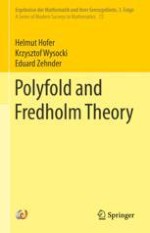This book pioneers a nonlinear Fredholm theory in a general class of spaces called polyfolds. The theory generalizes certain aspects of nonlinear analysis and differential geometry, and combines them with a pinch of category theory to incorporate local symmetries. On the differential geometrical side, the book introduces a large class of `smooth’ spaces and bundles which can have locally varying dimensions (finite or infinite-dimensional). These bundles come with an important class of sections, which display properties reminiscent of classical nonlinear Fredholm theory and allow for implicit function theorems. Within this nonlinear analysis framework, a versatile transversality and perturbation theory is developed to also cover equivariant settings.
The theory presented in this book was initiated by the authors between 2007-2010, motivated by nonlinear moduli problems in symplectic geometry. Such problems are usually described locally as nonlinear elliptic systems, and they have to be studied up to a notion of isomorphism. This introduces symmetries, since such a system can be isomorphic to itself in different ways. Bubbling-off phenomena are common and have to be completely understood to produce algebraic invariants. This requires a transversality theory for bubbling-off phenomena in the presence of symmetries. Very often, even in concrete applications, geometric perturbations are not general enough to achieve transversality, and abstract perturbations have to be considered. The theory is already being successfully applied to its intended applications in symplectic geometry, and should find applications to many other areas where partial differential equations, geometry and functional analysis meet.
Written by its originators, Polyfold and Fredholm Theory is an authoritative and comprehensive treatise of polyfold theory. It will prove invaluable for researchers studying nonlinear elliptic problems arising in geometric contexts.
